What Is a Steam Card and How Does It Work
![]()
Valve's Steam platform has sure come a long way since its release nearly ten years ago, and in recent years, the company's shown no signs of slowing down. In fact, it seems that Valve isn't content with just being the dominant gaming service for the PC: it wants even more growth, and would love nothing more than to convince console gamers that the PC is where it's at.
To accomplish this, the company has unveiled a slew of features since 2010 that aim to lure more people in, and make those already in open their wallets further. For starters, there's Mac OS X and Linux support. Then there's the Market, Greenlight, Workshop (modding), Software, Big Picture Mode (TV use) and… am I missing something? Oh, that's right: Steam Trading Cards, the topic of this article :slaphead:.
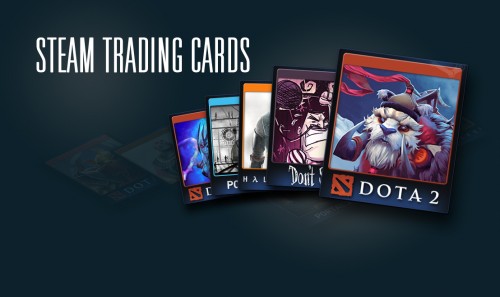
When Valve introduced Steam Trading Cards in May, I wasn't too sure what to think. Was it just a gimmick? Could it succeed? I had doubts at first, but then I realized it's Valve we're talking about. It doesn't fail at its endeavours all-too-often. Sure enough, Trading Cards are a hit.
To understand the success, it helps to understand what these cards do.
Steam is the largest digital game platform around, but with Trading Cards, Valve in effect made Steam a game as well. In fact, it's a bit like an RPG, where you must collect items, craft, and level-up with increasing difficulty. Who saw something like this ever hitting the service? I sure didn't.

Crafting a set of Steam Cards
As "Steam Levels" are gained, the user's account becomes enhanced. Each level adds 5 slots to the friend's list cap, and each 10 adds the ability to add a new widget to the profile. Some notable widgets include "Badge Collector", "Rarest Achievement Showcase", "Achievement Showcase", "Screenshot Showcase", "Favorite Game" and "Game Collector'. Those who have a higher Steam Level have a more interesting Steam profile, thanks to these widgets.
To gain a Steam Level, a set of cards must be crafted; some games might require just a couple of cards, while another could require a lot (the lowest I've seen is 5; the highest, 15). A set of cards, regardless of what they are, has a flat XP rate of 100 XP for completion. Further, each game has a total of 5 sets that can be acquired, all built using the exact same single cards. The more sets you complete, the cooler your badge looks, and the more rewards you'll earn.
Here's an example of what it looks like after a badge is crafted and a new level tier is reached:
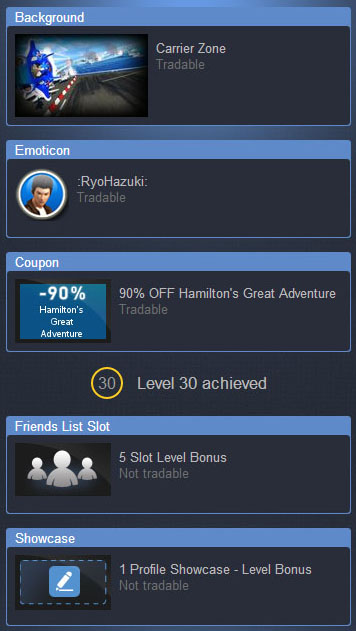
Rewards from building a badge and leveling-up
It's guaranteed that each badge created will reward a profile background and emoticon related to the game, and then a coupon on the side for a random game (and a random % value; I've seen multiple coupons for the same game but different values). If you're an active crafter, expect to see a lot of these. Not surprisingly, these coupons have an expiration date, of about 2 weeks after acquisition. You can't sell these, nor delete them, but you can trade them.
The primary way to earn XP is by crafting sets of cards (the process is as simple as going into a badge that has a complete set and click "Craft Badge"), but Steam has a couple of mechanics on the side that can give a boost as well. Participating in its mega-sales, for example, can earn you some XP; reaching a new tier of owned games, taking care of community tasks and simply being a member of Steam year-after-year, can as well. However, most XP income comes from crafting cards, and for many, that will require hauling out the wallet.
Regardless of the game, you will only be able to earn half of a set of cards (or half + 1 if the game has an odd number) before you have to get creative. And sometimes, you might earn two or more of the same card – it's completely random. If you have an excess, you can sell it off. You'd then in turn use what you've earned to go purchase what you do need, but unless you have a massive game collection and don't mind not crafting badges for every single game, you're going to end up spending money. Valve sure thought this one through.
To complete five sets of cards for a game without spending money, you'd realistically need 9 other games that will allow you to generate cards. An exception is when you have a game that has cards worth more than the average.
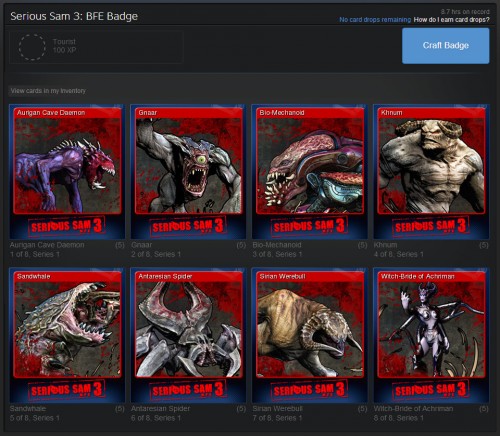
Ready to craft a set of cards
There are a couple of variables that come into play with card pricing, despite it all being chosen by the community. If a set of cards requires fewer cards to complete, the card values tend to be a bit higher; and then the opposite is true. If a game is mega-popular and affordable, its card values are usually low ($0.10-0.20); if a game is popular but expensive, you'll see mid-range values ($0.30); and if a game isn't priced too low and isn't that popular (in the grand scheme), those tend to be the most expensive ($0.40+).
Regardless of whether or not you haul out your wallet, you're likely interested in making the most of whatever you have in your Steam Wallet. For this, you might want to stalk the page of the card you need, and refresh on occasion. It's not uncommon for someone to price a card much lower than normal just to clear it out – and believe me, those go fast.
I mentioned above the fact that each game has 5 sets of cards to craft, but those 5 are the regular sets. There's an extra, called "Foil". These sets don't earn you anything different from crafting, and still earn you the same amount of XP as a regular deck. Those who seek these out would be hardcore fans of that particular game, wanting to show off the more advanced badge on their profile. Because Foil cards are rarer than normal cards, it's not uncommon to see their values at least 5x that of a regular card.
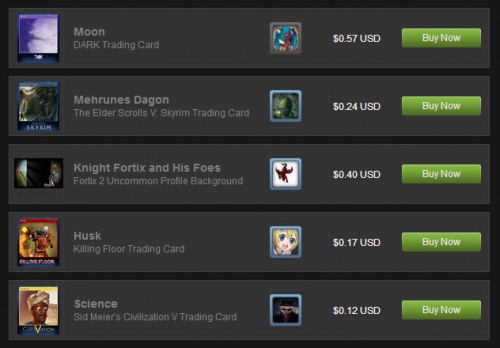
Card values are all over the place
Trading Cards might not interest a lot of people, and I'm sure there are those who don't care about upgrading their profiles. But that doesn't mean that collecting the cards should just be brushed aside, as there's another purpose for them: collect and sell. During this summer's Steam sale, a friend of mine sold a bunch of cards and was able to pick up F1 2012 with the proceeds. Of course, it'll help if your game collection is rather large, but money is money, right? Even if you only supplement that new game with cards, it was probably worth it, especially since earning every card a game will give you only requires it to be left open for a couple of hours (inflating your gametime; GG, Valve).
So with all of this talk about cards and XP, exactly how much XP is required per level? I likened Steam to an "RPG" earlier thanks to this trading cards mechanic, but where it's not like an RPG is with its easy-to-follow XP table. There's none of this nonsense where the next level will require 33% more XP than the current and then the one after that requiring 50% or some other random percentage more.
Each level within each set of ten (1 – 10, 2 – 20, etc) has the exact same XP requirement to reach the next level; each level between 1 – 10 requires 100 XP, and each between 2- 20 requires 200 XP. Once a new tier is reached, a requirement of +100 XP is tacked on to the last tier's requirement. This table can explain it even easier:
| XP Per Level | Total XP @ Level | |
| Level 1 – 10 | 100 | 1,000 @ Level 10 |
| Level 11 – 20 | 200 | 3,000 @ Level 20 |
| Level 21 – 30 | 300 | 6,000 @ Level 30 |
| Level 31 – 40 | 400 | 10,000 @ Level 40 |
| Level 41 – 50 | 500 | 15,000 @ Level 50 |
| Required and total XP for levels 0 – 200 can be seen here. | ||
Level 0 is possible, but it applies to brand-new Steam accounts that have done nothing of value – including purchasing a game.
When Valve first announced Steam Trading Cards, it made mention of level 50, which at the time seemed high (I debuted at level 10 or something like that). After this summer's sale, though, level 50 was shattered, with a number of people hitting level 100, and some well beyond that.
Let's do some math, shall we?
Given each badge rewards 100 XP, it means that it would take 150 of them to reach level 50 (15,000 XP). If you're like me and prefer to craft five badges per game before moving onto the next one, that means completing 30 different game badges (let's ignore the Foil badges because those are expensive just for the sake of rarity).
By some accounts, level 50 is modest – many 100+s exist, after all.
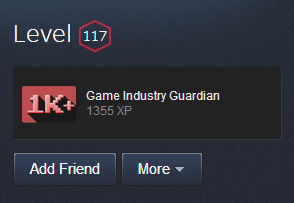
I have some catching-up to do…
To reach level 100 (55,000 XP), 550 badges must be created, which is equivalent to 110 maxed-out games (again, 5 badges per game). User PalmDesert has already reached level 150 (120,000 XP), which is the equivalent of 1,200 badges, or 240 maxed-out games. If this user wishes to reach 200, that'll be 210,000 XP, equivalent to 2,100 badges and 420 maxed-out games. Ugh… where did this headache come from?
After the recent Steam sale, I had wondered if Valve had foreseen this sort of dedication from gamers, but then I realized something: once level 100 is reached, the circle around the level becomes a hexagon.Of course Valve expected this. Reaching high levels cannot be done without spending money, and some of these gamers are spending a lot of it. That's some serious e-peen dedication, and I'm sure Valve doesn't mind the revenue.
So there you have it, everything you need to know about Steam cards, and the sad realization that reaching a high level is either going to take an eternity, or cost you money (or earn you some if you couldn't care less about your level).
Before wrapping-up, I have to give a plug to Steam Card Exchange. This is a site that shows you everything you can potentially earn from a badge, along with the badges themselves. Further, there's an automatic service offered where you can trade your Steam cards with bots, although that's something I never gave a try. It's definitely cool to have a service like it though.
Support our efforts! With ad revenue at an all-time low for written websites, we're relying more than ever on reader support to help us continue putting so much effort into this type of content. You can support us by becoming a Patron, or by using our Amazon shopping affiliate links listed through our articles. Thanks for your support!
What Is a Steam Card and How Does It Work
Source: https://techgage.com/article/steam-cards-how-do-they-work/
0 Response to "What Is a Steam Card and How Does It Work"
Post a Comment